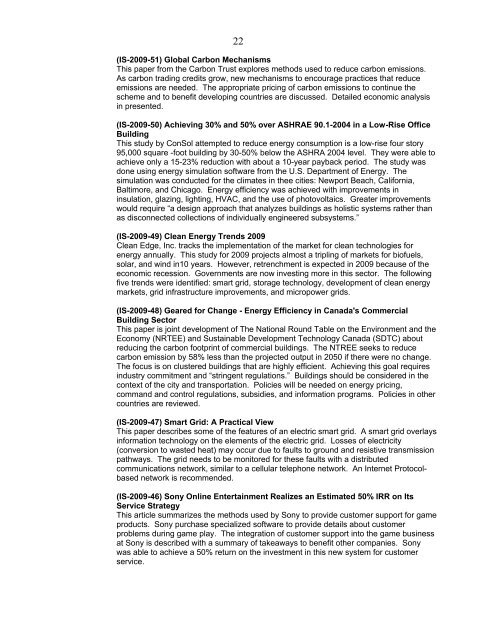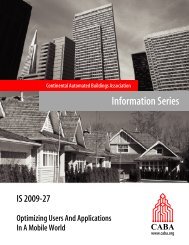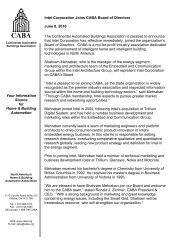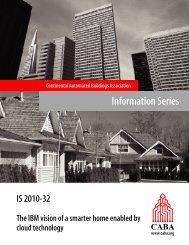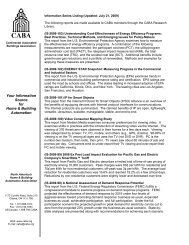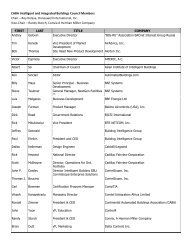Your Information Source for Home & Building Automation
Your Information Source for Home & Building Automation
Your Information Source for Home & Building Automation
You also want an ePaper? Increase the reach of your titles
YUMPU automatically turns print PDFs into web optimized ePapers that Google loves.
22<br />
(IS-2009-51) Global Carbon Mechanisms<br />
This paper from the Carbon Trust explores methods used to reduce carbon emissions.<br />
As carbon trading credits grow, new mechanisms to encourage practices that reduce<br />
emissions are needed. The appropriate pricing of carbon emissions to continue the<br />
scheme and to benefit developing countries are discussed. Detailed economic analysis<br />
in presented.<br />
(IS-2009-50) Achieving 30% and 50% over ASHRAE 90.1-2004 in a Low-Rise Office<br />
<strong>Building</strong><br />
This study by ConSol attempted to reduce energy consumption is a low-rise four story<br />
95,000 square -foot building by 30-50% below the ASHRA 2004 level. They were able to<br />
achieve only a 15-23% reduction with about a 10-year payback period. The study was<br />
done using energy simulation software from the U.S. Department of Energy. The<br />
simulation was conducted <strong>for</strong> the climates in thee cities: Newport Beach, Cali<strong>for</strong>nia,<br />
Baltimore, and Chicago. Energy efficiency was achieved with improvements in<br />
insulation, glazing, lighting, HVAC, and the use of photovoltaics. Greater improvements<br />
would require “a design approach that analyzes buildings as holistic systems rather than<br />
as disconnected collections of individually engineered subsystems.”<br />
(IS-2009-49) Clean Energy Trends 2009<br />
Clean Edge, Inc. tracks the implementation of the market <strong>for</strong> clean technologies <strong>for</strong><br />
energy annually. This study <strong>for</strong> 2009 projects almost a tripling of markets <strong>for</strong> biofuels,<br />
solar, and wind in10 years. However, retrenchment is expected in 2009 because of the<br />
economic recession. Governments are now investing more in this sector. The following<br />
five trends were identified: smart grid, storage technology, development of clean energy<br />
markets, grid infrastructure improvements, and micropower grids.<br />
(IS-2009-48) Geared <strong>for</strong> Change - Energy Efficiency in Canada's Commercial<br />
<strong>Building</strong> Sector<br />
This paper is joint development of The National Round Table on the Environment and the<br />
Economy (NRTEE) and Sustainable Development Technology Canada (SDTC) about<br />
reducing the carbon footprint of commercial buildings. The NTREE seeks to reduce<br />
carbon emission by 58% less than the projected output in 2050 if there were no change.<br />
The focus is on clustered buildings that are highly efficient. Achieving this goal requires<br />
industry commitment and “stringent regulations.” <strong>Building</strong>s should be considered in the<br />
context of the city and transportation. Policies will be needed on energy pricing,<br />
command and control regulations, subsidies, and in<strong>for</strong>mation programs. Policies in other<br />
countries are reviewed.<br />
(IS-2009-47) Smart Grid: A Practical View<br />
This paper describes some of the features of an electric smart grid. A smart grid overlays<br />
in<strong>for</strong>mation technology on the elements of the electric grid. Losses of electricity<br />
(conversion to wasted heat) may occur due to faults to ground and resistive transmission<br />
pathways. The grid needs to be monitored <strong>for</strong> these faults with a distributed<br />
communications network, similar to a cellular telephone network. An Internet Protocolbased<br />
network is recommended.<br />
(IS-2009-46) Sony Online Entertainment Realizes an Estimated 50% IRR on Its<br />
Service Strategy<br />
This article summarizes the methods used by Sony to provide customer support <strong>for</strong> game<br />
products. Sony purchase specialized software to provide details about customer<br />
problems during game play. The integration of customer support into the game business<br />
at Sony is described with a summary of takeaways to benefit other companies. Sony<br />
was able to achieve a 50% return on the investment in this new system <strong>for</strong> customer<br />
service.


